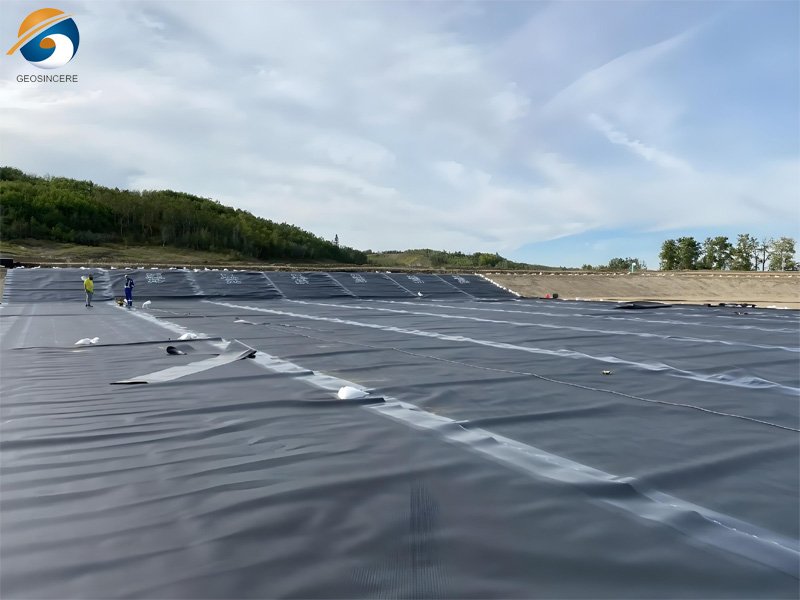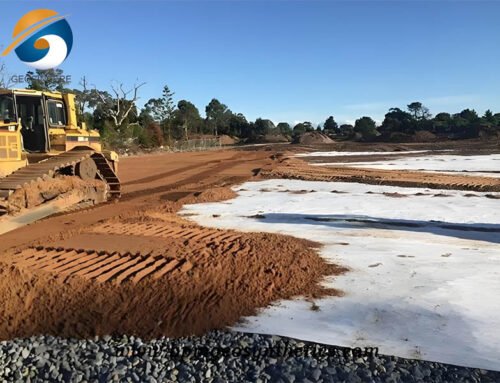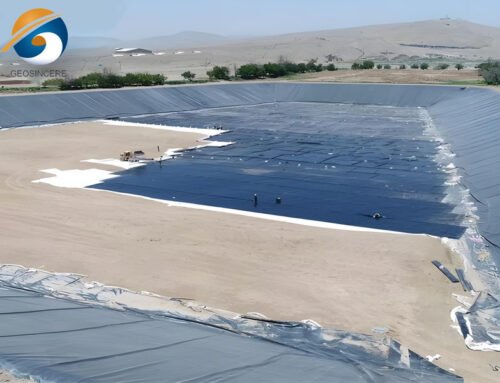Geomembrane for Landfills are integral components in modern landfill engineering, acting as impermeable barriers that prevent contaminants, such as leachate, from seeping into the surrounding environment. As environmental concerns grow and regulations become more stringent, selecting the appropriate geomembrane for landfill applications is no longer just a technical decision; it is a matter of compliance, sustainability, and public responsibility. The process involves more than just choosing a material—it requires a comprehensive understanding of the specific needs of the landfill site, including waste composition, environmental factors, and long-term durability.
In this article, we will discuss key considerations when selecting a geomembrane for landfill projects, focusing on material properties, thickness, chemical compatibility, installation techniques, and environmental impact. By understanding these factors, engineers and project managers can ensure that their choice of GEOSINCERE geomembrane will not only meet regulatory standards but also provide long-lasting protection for the environment.
1. Understanding Geomembrane For Landfills Materials
The first and most crucial step in selecting a geomembrane is understanding the various material options available. Each type of polymer has distinct benefits and limitations based on the landfill’s specific needs. Here are the most commonly used materials for geomembranes:
1.1 High-Density Polyethylene (HDPE):
HDPE is the most widely used geomembrane material due to its exceptional chemical resistance, UV stability, and cost-effectiveness. It is well-suited for large-scale landfill projects that require long-term impermeability. However, HDPE is relatively rigid and may not perform well in areas with uneven terrain or potential ground movement.
1.2 Linear Low-Density Polyethylene (LLDPE):
LLDPE offers greater flexibility compared to HDPE, making it a better choice for landfills located in areas with irregular surfaces or those prone to ground shifting. While LLDPE has a lower chemical resistance than HDPE, advancements in additive technology have improved its performance, providing a balance between flexibility and durability.
1.3 Polyvinyl Chloride (PVC):
PVC geomembranes are highly flexible and easy to install, especially in complex geometries. This makes PVC an ideal option for smaller landfills or temporary containment systems. However, PVC may degrade when exposed to UV radiation and extreme temperatures, limiting its long-term use in outdoor applications.
1.4 Ethylene Propylene Diene Monomer (EPDM):
EPDM is a synthetic rubber that excels in flexibility and resistance to weathering. It performs well in regions with significant temperature fluctuations. However, EPDM’s resistance to chemical exposure, particularly hydrocarbon-based chemicals, is limited, making it unsuitable for landfills handling industrial waste.
1.5 Thermoplastic Polyolefin (TPO):
TPO combines the flexibility of PVC with the chemical resistance of polyolefins. It is increasingly favored for landfills exposed to harsh environmental conditions. However, TPO often requires specialized welding techniques for installation, which can add to the project’s cost and complexity.
Key Takeaway: The choice of material should align with the specific waste type, climate conditions, and operational lifespan of the landfill. For hazardous waste landfills, HDPE is often the best choice due to its robustness, while LLDPE is suitable for municipal waste in stable environments.


2. Geomembrane For Landfills – Thickness and Puncture Resistance
The thickness of a geomembrane significantly affects its puncture resistance and durability. Thicker geomembranes (1.5–3.0 mm) are essential for landfills that handle sharp or heavy waste, such as construction debris. Thinner geomembranes (0.5–1.0 mm) may be adequate for inert waste but come with an increased risk of failure under stress or sharp objects.
Key factors influencing the choice of thickness include:
- Subgrade Preparation: Proper compaction and smoothing of the subgrade will help reduce stress on the geomembrane during installation and waste compaction.
- Protection Layers: The use of protective layers, such as non-woven geotextiles or additional soil layers, can shield the geomembrane from abrasion and potential punctures.
- Waste Type: Hazardous waste with corrosive components often requires a thicker, more chemically resistant geomembrane to ensure long-term containment.
3. Geomembrane For Landfills – Chemical Compatibility
Landfill leachate, the liquid that seeps from waste, can contain a variety of aggressive chemicals, including solvents, acids, and heavy metals. It is crucial to select a geomembrane that can withstand prolonged exposure to these chemicals without degradation. When assessing chemical compatibility, the following factors should be considered:
3.1 Geomembrane For Landfills – Permeation Rates:
The rate at which chemicals permeate the geomembrane should be low to prevent leachate from reaching surrounding groundwater.
3.2 Geomembrane For Landfills – Chemical Effects:
Testing should assess the potential for the geomembrane to swell, crack, or become brittle when exposed to specific chemicals. ASTM standards (e.g., ASTM D5322) provide guidance for evaluating chemical resistance.
3.3 Geomembrane For Landfills – Temperature Effects:
The interaction between chemicals and geomembranes can be affected by temperature. Therefore, temperature fluctuations and their impact on chemical reactions should be considered when selecting a material.
For example, HDPE is highly resistant to hydrocarbons and chlorinated solvents, making it an excellent choice for landfills dealing with chemical or industrial waste. In contrast, PVC may degrade when exposed to certain chemicals like ketones or esters.
4. Geomembrane For Landfills – Environmental and Climatic Factors
Environmental and climatic conditions play a significant role in the performance of a geomembrane. Key factors to consider include:
4.1 Geomembrane For Landfills – UV Exposure:
Prolonged exposure to sunlight can cause degradation of the geomembrane material. HDPE with carbon-black stabilization offers excellent UV resistance and can last for several decades without degradation.
4.2 Geomembrane For Landfills – Temperature Extremes:
In cold climates, materials like LLDPE are preferable because they retain flexibility at low temperatures. Conversely, in hot regions, HDPE’s resistance to thermal expansion and oxidative aging makes it a better option.
4.3 Geomembrane For Landfills – Wind and Erosion:
For temporary landfill covers, geomembranes must be properly anchored or ballasted to prevent wind damage or erosion, particularly in exposed areas.
5. Installation and Seaming Requirements
The installation of geomembranes is a critical factor in their long-term performance. A poorly installed geomembrane can lead to failures and environmental contamination. Consider the following during installation:
5.1 Welding Techniques:
Geomembranes such as HDPE and LLDPE are typically welded using thermal fusion techniques, while PVC requires solvent welding. Consistent seam strength is essential for ensuring leak-free installations.
5.2 Quality Assurance:
Destructive and non-destructive tests, such as air lance or spark testing, should be conducted to verify the integrity of the seams.
5.3 Slope Stability:
For landfills with steep slopes, textured geomembranes can enhance friction and prevent slippage.
6. Regulatory Compliance
Landfills are subject to strict environmental regulations, both locally and internationally. Geomembranes used in landfills must meet various regulatory standards, such as:
- EPA Guidelines (USA): These guidelines mandate minimum thickness and permeability standards for geomembranes used in landfill applications.
- EU Landfill Directive: This directive requires that geomembranes effectively prevent groundwater contamination.
- ISO Standards: ISO 12958 assesses water vapor transmission, while ISO 13426 evaluates seam strength.
It is essential to verify that the selected geomembrane meets or exceeds all applicable regulatory thresholds to ensure legal compliance and environmental protection.
7. Cost vs. Long-Term Value
While budget considerations are essential, it is vital to balance initial cost with long-term value. Cheaper geomembranes may offer short-term savings but could result in significant environmental and financial costs if they fail prematurely. Key points to consider include:
- Lifecycle Costs: Thicker geomembranes, such as HDPE, may have higher upfront costs but can last 50+ years with minimal maintenance, providing a better return on investment over time.
- Warranties: Many manufacturers offer warranties that guarantee material performance for a specified period, helping to mitigate the risk of material failure.
- Environmental Liabilities: A failed geomembrane can lead to costly cleanup operations, legal penalties, and potential damage to the company’s reputation.


8. Sustainability Considerations
As environmental awareness grows, many landfills are shifting toward more sustainable materials. Some geomembranes now incorporate:
- Recycled Content: Certain geomembranes are made with post-consumer recycled polymers, contributing to the circular economy.
- End-of-Life Recycling: HDPE and LLDPE geomembranes can be recycled into new construction materials or repurposed for other applications.
- Low-Carbon Manufacturing: Opting for geomembrane suppliers that use renewable energy in production can help reduce the carbon footprint of the landfill construction process.
9. Conclusion
Selecting the appropriate geomembrane for a landfill project is a complex and multifaceted decision. It requires a thorough understanding of the site’s waste composition, environmental factors, regulatory requirements, and long-term performance expectations. By carefully evaluating material properties, thickness, chemical compatibility, and installation requirements, engineers can ensure that the selected geomembrane provides reliable and durable protection for the environment.
Ultimately, a well-chosen geomembrane not only safeguards public health and ecosystems but also aligns with the growing emphasis on sustainability in modern landfill engineering. By prioritizing material performance, environmental responsibility, and long-term value, landfill operators can ensure the safe containment of waste while minimizing their environmental impact. Geomembranes are more than just liners—they are essential tools in preserving the health of the planet for future generations.





